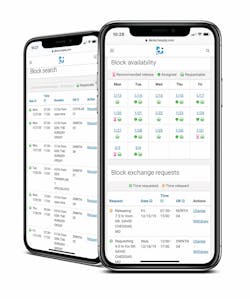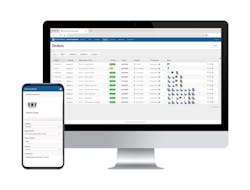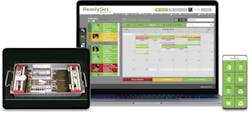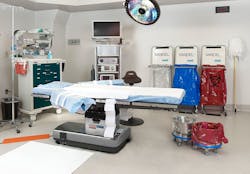One thing is certain, the healthcare landscape constantly is revolving. In more “normal” times, operating rooms (ORs), emergency rooms (ERs) and hospitals may churn around the clock, scheduling patients and moving them in and out for the critical care they need. The ongoing COVID-19 pandemic, however, propelled a new level of changes and complications in patient volumes, staffing, supplies, flow, and bottom lines in care.
“Healthcare facilities are facing a backlog of elective surgeries, less availability and rising costs of supplies, staffing shortages, and maintaining a safe environment during this pandemic,” addressed Gina Gilbert, Senior Director of Professional Education & Clinical Affairs, Ansell.
Scheduling procedures is a difficulty in care, observes Shawn Sefton, MBA, BSN, RN, VP of Client Operations and CNO, Hospital IQ.
“A consistent theme I’ve heard from perioperative leaders is that many challenges arise from scheduling procedural cases and then creating an efficient throughput process that optimizes both patient care and business objectives,” Sefton shared. “COVID has definitely increased these challenges and all perioperative services are impacted like other areas.”
So, how else is the crisis affecting procedure scheduling, room turnover, and OR, elective surgery or hospital care? And what are the effects on patients, staff and facilities?
Patient volume shift
During the pandemic, there has been a decline in the numbers of patients going to hospitals for care or procedures.
“Volume is clearly down for 2020,” Sefton indicated. “Mandated cancellations in the spring are the most significant factor, but even with those restrictions lifted, caseloads in many areas haven’t returned to previous levels. You also have patients reluctant to come to the hospital, those that have lost their insurance coverage, or those that test positive for COVID before the scheduled procedure, which causes a cancellation.”
Keerthi Kanubaddi, CEO, ReadySet Surgical, adds that as levels of patients in hospitals are lower, staff has been reduced and affected by the crisis.
“Even with the most recent COVID-19 surge, we are seeing that hospital volumes overall are still down by single digits, which have recovered slightly due to the massive influx of COVID-19 patients,” he addressed. “Capacity of care is still a challenge, given that hospitals have laid off or furloughed staff to manage the significant volume losses in 2020. Existing staff are severely taxed, and staff have been impacted by COVID-19. Overall care has been impacted as well.”
Critical surgeries also have decreased and elective surgeries are backed up, continues Kanubaddi.
“Specific procedure areas, like orthopedic replacements and cardiac procedures, have markedly declined by double digits year over year,” he explained. “Some estimates point out that elective procedure volumes will be at 75 percent to 85 percent of pre-COVID capacity by the end of 2020, but that might even be too optimistic depending on infections in the local area. Add to this an anticipated backlog of elective procedures that is anywhere from six to 18 months by some estimates.”
Scheduling, inventory concerns
The crisis has disrupted the availability of supplies and the coordination of scheduling.
“Capacity of care has been hindered due to challenges with supply and demand,” Gilbert said. “Scheduling priorities drastically have changed globally, depending on the virus surge level. Patients with time-sensitive conditions may be prioritized over those considered elective, and others have been postponed altogether.”
Changes in business operations and care during the pandemic have impeded scheduling and turnover, expresses Sefton.
“Scheduling cases is more difficult now because so many contingencies are subject to a quick change, whether from government guidelines, hospital capacity, testing requirements, or patient issues,” she explained. “COVID-induced constraints and an increased emphasis on sterility and cleanliness are all causing breakdowns in scheduling, flow, and turnover, increasing the hurdles for the OR desk.”
Managing clinician time is essential for enhancing scheduling, workflows and care.
Sefton points to Hospital IQ’s technology system to help provide real-time transparency in scheduling surgeries.
“Surgeries will continue to rebound through 2021 but will face COVID-related inpatient capacity challenges as many perioperative departments are siloed from the inpatient units,” she indicated. “OR leaders lack visibility into real-time or future capacity as they move patients through the OR. Using AI, our solution prompts block-holders to release time they likely won’t need so other surgeons have adequate time to request that open time. This summer when elective cases again were permitted in New York, a customer of ours used this capability to turn a majority of their existing block schedule into open time, and then surgeons and perioperative leaders worked together to prioritize and schedule cases to work through their backlog of rescheduled cases.”
Facilities must remain flexible in handling changes in scheduling and care, according to Kanubaddi.
“The massive influx of COVID-19 patients has stressed normal operating procedures at hospitals, including elective procedures,” he stated. “While those procedures are down significantly year over year, hospitals are prioritizing procedure types to manage given the current shifting environment. Patient turnover also has been impacted notably, as COVID patients are sicker and take longer to recuperate in many instances.”
Kanubaddi highlights ReadySet Surgical’s technology to help manage device tracking, patient scheduling, and room turnover.
“Our first application, RS Track, has provided asset tracking functionality around surgical trays and implants,” he explained. “Given extremely taxed supply chains, this visibility has proven very effective in supporting scheduled procedures. Our RS Coordinate solution, which includes RS Track, provides automated advanced scheduling and vendor notification, which has helped improve scheduling efficiency and turnover. A leading Children’s Hospital increased notification lead time by 66.3 percent to 14.3 days and loaner tray arrival time by 500 percent to 48 hours before the case.”
A new portal by CenTrak provides automated management of inventory and care assignments.
According to a CenTrak press release1, “CenTrak has announced the availability of OnDemandOrder, a centralized portal for managing requests for mobile medical equipment and other support services across the healthcare enterprise. The portal can be used as a standalone SaaS (software-as-a-service) solution or incorporated into a more robust RTLS (real-time location system) that uses a combination of sensors and software to automate procurement when supplies run low.”
The company continued, “For clinicians, it offers a convenient tool for submitting requests for equipment and support. The ordering tool’s user interface is designed to mimic the online consumer shopping experience and features configurable product categories, such as PPE (personal protective equipment) and environmental services. It allows staff to designate a level of urgency to each request and view the real-time status of their orders, which are automatically routed to delivery teams and prioritized for fulfillment. OnDemandOrder also automates regular work assignments related to inventory management, including PAR level replenishment and the retrieval of soiled equipment. Supply chain managers and other healthcare administrators can use the system’s backend to monitor PAR levels in real time and use its advanced reporting and analytics capabilities to identify inefficient workflows or inventory utilization.”
ReadySet Surgical’s technology additionally includes a system for managing OR equipment and purchases, shares Kanubaddi.
“Equipment shortages also have impacted care of COVID-19 patients, but supply availability has improved,” he noted. “Up to 85 percent of OR delays are equipment-related issues. RS Analyze, our ‘bill only’ charge capture solution, has provided 100 percent charge accuracy, decreased lag time 97 percent for ‘bill-only’ submissions, and decreased surgical invoice processing time by 75 percent. RS Analyze provides deep insight into non-compliant purchases by physicians and staff, as well as graded vendor and vendor rep performance.”
Safety and turnover priorities
The pandemic has increased concentration on cleanliness, disinfection, and timing of throughput in surgical care, according to Gilbert.
“Surgeries are being performed with a greater emphasis on safety, environmental hygiene and a heightened focus on turnover,” she stated. “Detailed infection control protocols are being expanded to minimize risk of exposure, including OR cleaning, use of disposable kits and supplies, in addition to expanded education and training. Cleaning procedures are more involved and time consuming. As surgeries ebb and flow during various surges of the pandemic, improving OR turnover speed is critical. Utilizing standardized products, procedures and processes translates into providing a safer and more effective surgical environment.”
Cleaning and turnover products from Ansell help support protection, safety, and flow in care, continues Gilbert.
“Ansell’s STAT-BLOC disposable linens are the only antimicrobial offering available, recently tested to show 99 percent effectiveness against COVID-19, in addition to 99.9 percent effectiveness against E. coli, MRSA and CRE,” she indicated. “Ansell’s STAT-PAC Room Turnover Kits help to improve efficiency, reduce the risk of cross contamination, reduce lint, prevent skin breakdown and eliminate costs associated with reusable linens. In addition, Ansell offers a new clinically based program – AdvisOR – where facility turnovers are evaluated against AORN best practices through observational surveys, turnover time, and ATP (adenosine triphosphate) testing data in a collaborative effort to improve room turnover outcomes and effectiveness.”
A new report by Fact.MR shows a rise in healthcare procedures, patient volumes, and risk of infections on a global scale.
According to a Fact.MR press release2, “Growth rate of the global healthcare industry has been around seven percent in recent years, which is expected to increase to over nine percent over the next five years. With a growing healthcare industry, including multi-specialty hospitals, clinics, and others, there has been an increase in the number of patients. This also means increased chances of acquiring hospital-associated infections while being treated.”
The prepackaged item market is increasing, noted the company.
“While the COVID-19 pandemic affected production across manufacturing units for a while, contrary to this, there has been surge in demand due to the rush of patients in clinics, ambulatory surgical centers, and others. This has fueled the growth of the prepackaged medical kits and trays market and is anticipated to drive the market further over the next few years.”
The disposable product market also is expanding, added the company.
“The global medical disposable market size was estimated at US $248 billion in 2019 and is rising steadily to cross US $280 billion in 2020. As the healthcare industry, especially the multi-specialty hospital industry, is growing at a steady pace, demand for prepackaged medical kits and trays is skyrocketing. Increase in awareness among patients, doctors, medical staff, and others is further catering to market growth.”
References
1. CenTrak Announces OnDemandOrder to Automate Inventory Management, December 15, 2020, https://centrak.com/ondemandorder-to-automate-inventory-management/
2. Prepackaged Medical Kits and Trays Market Surging at 8.5% CAGR; COVID-19 Pandemic Crisis Lending Impetus to Market Growth: Fact.MR, Dec 14, 2020, https://www.factmr.com/media-release/1762/global-prepackaged-medical-kits-and-trays-market
About the Author

Ebony Smith
Ebony Smith was previously Managing Editor for Healthcare Purchasing News.




